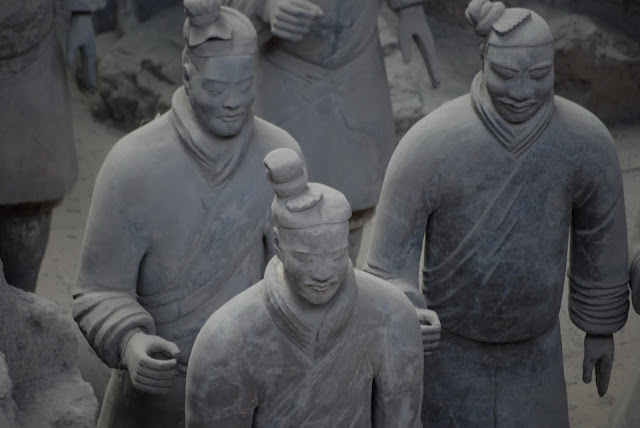This was my second visit to the Terracotta Warriors and Horses (兵马俑, bīngmǎyǒng). It involved waiting in an extremely long line for the bus and being jostled and shoved in the exhibit. But it was still worth it. There's just something intangibly amazing about them.
For those unfamiliar with the Terracotta Warriors, this pottery army was built in the late third century BC to be buried with Emperor Qin Shihuang, the first emperor of a unified China. He started work on the the site before he had even unified the country. It is estimated that there are more than 8,000 soldiers, 130 chariots with 4 horses each, and 150 cavalry horses, but most of them are still buried. The soldiers are life-sized, have various uniforms and hairstyles according to rank, stand in battle formation, and most of them originally held real weapons. They were also painted in colors that are now faded or absent. Perhaps most fascinatingly, each soldier has a unique face.
I had forgotten that their discovery was so recent, only found in 1974 when farmers were digging a well and found pottery shards. Four large pits have been excavated: three ongoing, one empty, suggesting that the emperor had planned an even larger array than was accomplished by his death. Here are views of pit number one.
 |
| Pit Number 1, as viewed from the entrance. |
 |
| And from the other side. |
 |
You can still make out some of these horses' coloring.
|

 |
| Pit number one is also the site of ongoing reconstruction work. |
 |
| Don't they look like they're standing at the starting gate, ready to be off and running? |
 |
| Reconstruction the warriors: fascinating or tedious? Probably both. |
 |
Looking back at the entrance. Apparently there are over 2 million visitors a year.
It felt like an unreasonable number of them were there when I was. |

































Hah! I've been waiting for your pictures of this. Even knowing about it, I had no idea of the enormous scope of it and the amazing variation and realism.
ReplyDelete